Yellow wasps in Québec are both useful and fascinating. They are very focused on their work. Unfortunately, their zeal can sometimes be a source of inconvenience, discomfort, or even stress. Fully enjoying our outdoor activities can then become a real challenge. In this blog, AJS helps our readers to better understand the behaviour of wasps, and offers a few tips on how to avoid having issues with them.
Identifying the yellow wasp that is a source of irritation in Québec
In the province of Québec, notably in Longueuil, three species of yellow and black wasps are most often a source of complaints: the German wasp (Vespula germanica), the common wasp (Vespula vulgaris), and the eastern yellowjacket (Vespula maculifrons). They are approximately 10 mm – 25 mm in length. They all look very much alike and essentially have the same behaviour.
Even though there are several other species of wasps in Québec, such as solitary wasps or potter wasps (also called mud wasps), this article will deal with the problems associated with the yellow and black wasps, which are the most widespread on Montréal’s South Shore. To get help in eliminating this parasite, contact AJS for a fast consultation.
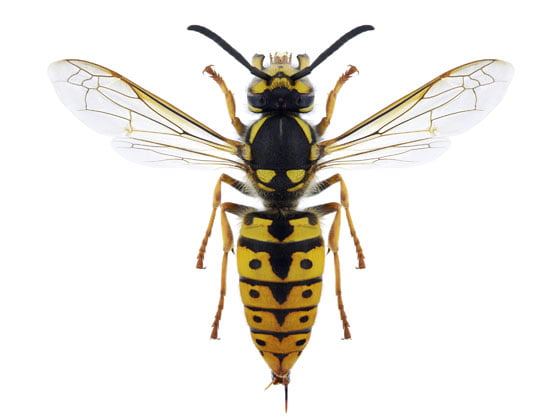
Life cycle
In spring, the lone queen wasp begins to build the small hexagonal cells that will contain the first eggs she will deposit inside. But. . . where did the queen come from, in fact? Actually, since the preceding fall, after she mated at the end of summer, the queen has spent the entire winter hiding, protected from the cold and snow. The nest she originally came from as well as all its original wasps were destroyed by the cold. So, when spring arrives, it’s up to her to begin the activities of a new nest of worker wasps.
At the beginning, the queen lays eggs that will only produce workers. She feeds those first larvae herself. Once grown, however, these first workers take over the task of expanding the nest, feeding the queen and the eggs as they continue to hatch. In the fall, the queen starts laying eggs that produce both males and other queens. Among the latter, those that mate with a male then leave the nest and seek a hiding place where they can hibernate until the following spring.
Habitat
When the queen awakens in spring, she seeks a location away from light and shielded from the elements, such as under a shed, a balcony, stairs or a cornice. She may also choose an attic, a false roof, a tree or shrub, or start her new nest behind a building’s sheathing or even in the ground.
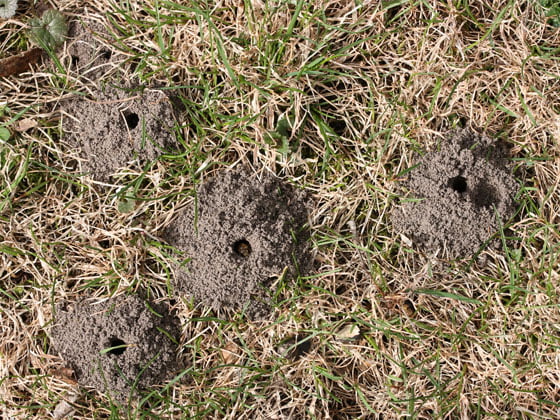
How does a queen wasp build the first cells of its nest? By mixing its saliva with plant fibres, which literally makes the nest look as if it is made of the classic “papier-mâché,” a kind of paper paste. The queen’s workers use the same process with various sources of fibre like bark, wood, plant stems, or even cardboard. This is why wasp nests may be of more than one colour aside from grey, depending on the fibres used.
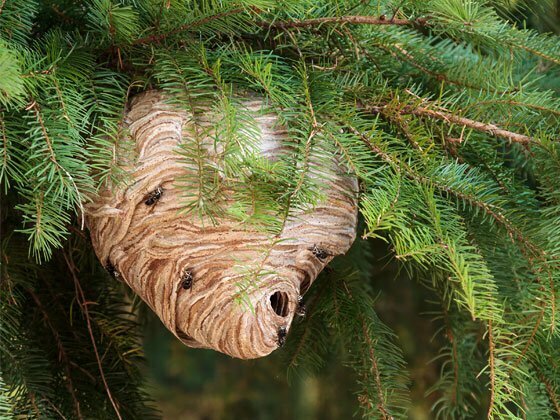
The wasps’ nest will eventually take the shape of a large football with an opening at the bottom. Depending on the species of wasp that built it, the nest may also look like an open parasol comprising only a few rows. The former can contain thousands of wasps, whereas the latter will house only about a hundred.
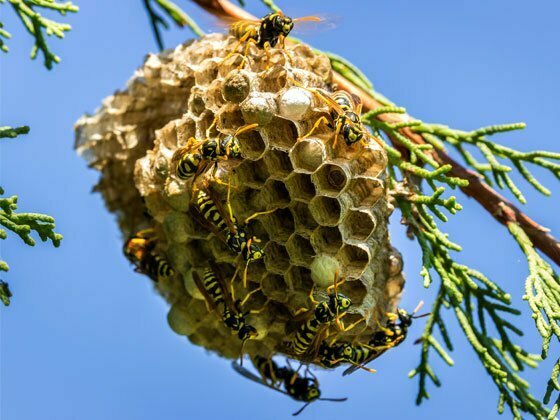
Eating habits
Unlike bees, yellow wasps are carnivorous. Their feeding habits therefore make them very useful in the garden, as they feed on other harmful insects like flies, aphids, caterpillars, other invertebrates and even carrion.
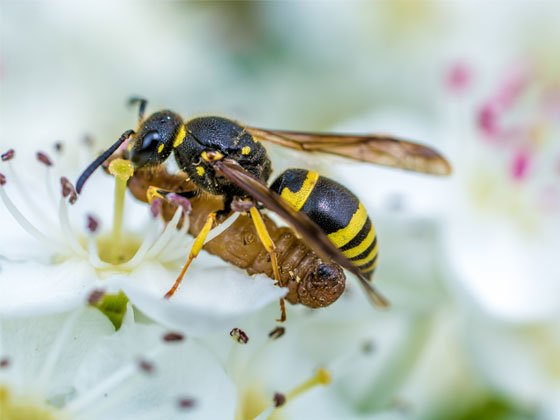
Wasps also eat nectar and any other sweet food that might attract them. And, because they gather nectar from flowers, they also participate in the pollination process, but not as much as bees.
Yellow wasps are also useful to other animals in the food chain, in that they are prey for spiders, birds and small mammals.
Harmful effects
As we can see, yellow wasps are very useful in nature. However, when they start living too close to our homes, two problems arise.
The first is felt when the wasps unexpectedly and persistently invite themselves to our outdoor meals. The way they buzz around us and the food on the table can be irritating and even intimidating.
Secondly, there’s the issue of allergies. A yellow wasp can sting more than once, and each time it injects a small quantity of venom. This sting is often painful, causing redness and swelling for a few days. Worse, some people are mortally allergic to the venom of the yellow wasp. Symptoms of a severe allergic reaction may include dizziness, itching, abnormal swelling or difficulty breathing. In such a case, medical assistance must be sought immediately.
Consequently, finding a wasp nest on our property inside our home can be a source of serious concern.
How do you know if there is a wasp’s nest nearby?
If you notice what looks like a ball of grey paper paste suspended to a tree or under a cornice for example, it is indeed a wasp nest.
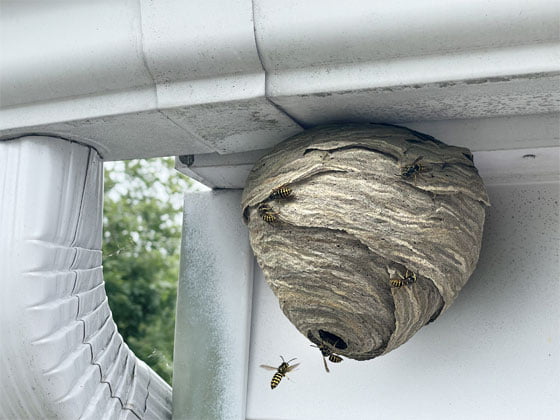
If you see wasps flying slowly and often near the same spot on the ground, or near your home’s outdoor siding or roof, it means a wasp nest is likely built in the ground or behind the house’s cladding.
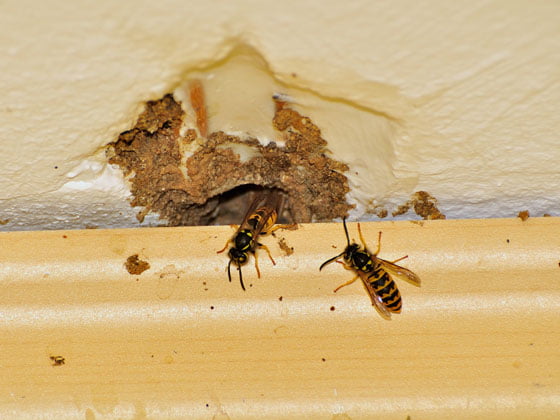
Exterminator tips
“It is recommended to call on the services of a specialist because of the increased risks of accident or multiple stings. If wasps have entered a building by an opening (like a cornice or soffit), a weep hole (used in brick cladding) or through some other fissure on the outside wall, don’t block the opening. Wasps will probably find another way to reach their nest, most likely through the inside of your home!” If you hear a buzzing sound or notice that a ceiling looks slightly warped, it is important to never knock or tap the surface, as you risk perforating the ceiling and opening up the inside of your home to possibly hundreds of wasps.”
Jacques, exterminator at AJS for 30 years.
Why are there wasps on my property?
As is the case with other useful insects that can sometimes become a nuisance (like carpenter ants, for example), something on your property attracted the wasps. Perhaps it was food.
Or, perhaps your property had several areas that were favourable for a queen wasp to hide over the winter (like a pile of dead leaves), thus giving her a head start to build a nest in spring.
Prevention tips to avoid yellow wasps
There are several things we can do so that our favourite outdoor activities are not constantly spoiled by the presence of wasps. For example:
- Put trash in containers that have a strong lid.
- Don’t wear perfume or hairspray or products, as these strong odours attract wasps.
- Cover food (including leftovers) and drinks when you eat outdoors.
- Don’t walk barefoot on grass, especially at the end of summer, as wasps are more numerous and active.
- If a wasp lands on you, don’t panic. Stay calm until it leaves, or sweep it away gently with your hand. Wasps are stressed by sudden movements, which leads them to instinctively adopt a defensive attitude that can lead them to sting.
What treatments are offered by AJS Extermination?
AJS sells products in store or online, as well as the services of a professional exterminator.
Toward the end of summer, wasp nests tend to be much larger and can be located in hard-to-reach places (like inside a wall). Trying to remove or destroy a wasp nest yourself can be risky or even dangerous.
The experts at AJS will know exactly how to proceed to protect your safety and your family’s.
Special preparation is not particularly required, except to clear the immediate surroundings of the nest and to avoid approaching the site for 24 hours after the wasp nest has been exterminated. Let AJS spare you the stress of this delicate task—we guarantee it. Get an appointment quickly by calling today!
Why trust our pest control services?
Choosing an exterminator isn’t something you can do lightly! Offers abound in the extermination sector, but a few important factors should be part of your research before you contact an exterminator: Do they offer a guarantee on their work? Does the company have sufficient experience? Is it possible to talk with a technician to obtain advice on prevention in order to avoid another infestation?
Don’t hesitate to call us — we’ll be glad to explain why thousands of customers value our service!
Outstanding service
Our exterminators perform honest work and provide advice on prevention so as to ensure long-term results.
Advanced technology
Our investment in new technologies ensures we achieve the best results to detect and exterminate insects.
Guaranteed results
We guarantee results of our complete treatments for the extermination of parasites according to the exterminator’s recommendation.
Ecofriendly methods
We always consider using integrated pest management methods (whether mechanical or biological solutions) before opting for methods that use chemicals.